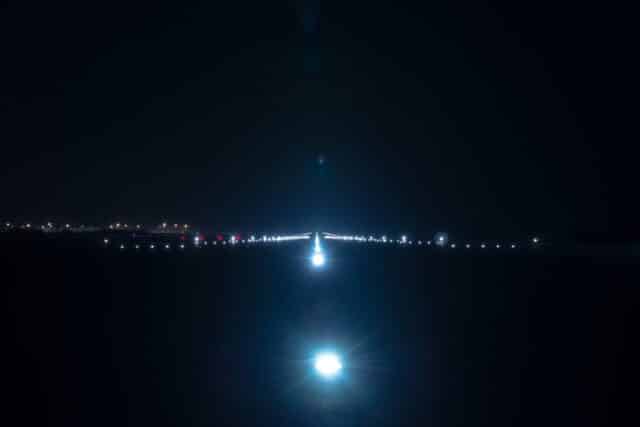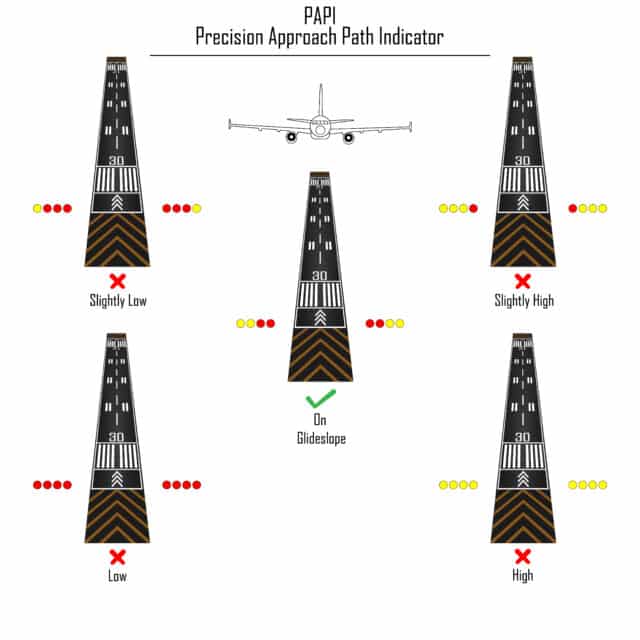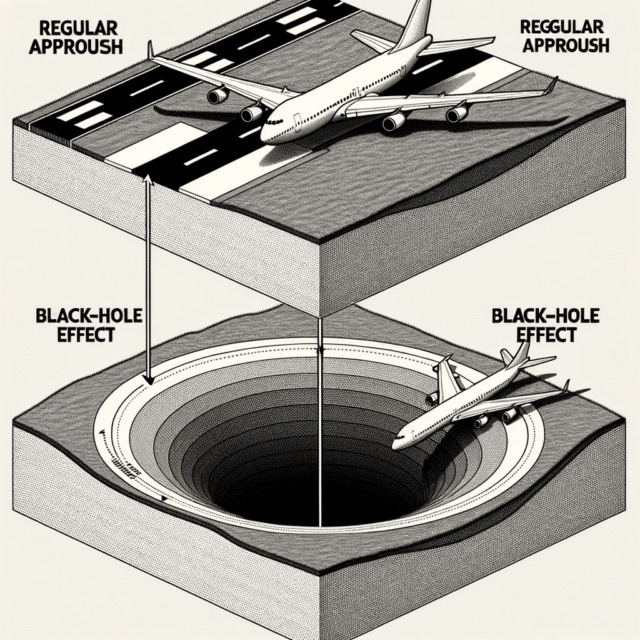Descending into Illusion: The Black Hole Effect
With no moon or city lights to guide you, the runway lights up ahead should be a beacon of safety. However, it might be a trap known as the black hole effect.
Understanding our position, motion and attitude is critical to safe flight. Spatial disorientation is a collection of sensory illusions which lead us to misinterpret a situation. Understanding our position relative to the ground is critical to safe flight, but our spatial orientation system is not optimised for flight. The result is that spatial disorientation in pilots is insidious and difficult to diagnose. In the grip of an illusion, you can easily manoeuvre into a fatal loss of control without ever realising that your perceptions are wrong.
The black hole effect is a specific instance of this; a visual illusion which occurs during the final approach at night or in low visibility where only the runway lights are visible. Also known as the “featureless terrain illusion”, this is a particular risk on dark nights, with no moon or starlight available.
Boeing first studied the black hole effect after a number of airliner accidents in the 1960s (Kraft and Elworth, 1969). Boeing instructor pilots with over 10,000 hours of flight time were put into a simulation of black hole conditions. If they did not maintain constant reference to the altimeter and glide slope information, most of them flew excessively low approaches and crashed into terrain short of the runway.

Our eyes aren’t designed for low-light vision. Terrain information helps to calibrate our perception of our orientation and position. If there’s no horizon and no ground lights between the aircraft and the runway threshold, our understanding of where the horizon is and what glideslope is needed for the approach becomes untrustworthy.
The pilot reacts by increasing the rate of descent, acting on the clear visual cues that the final approach needs to be steeper in order to land safely. The dangerously low approaches and aggressive descents often lead to Controlled Flight Into Terrain (CFIT) without leaving any clue as to why the pilot flew a perfectly serviceable aircraft into the ground.
Although the black hole effect is a visual illusion, it differs from most visual illusions in that cross-referencing your instruments will not necessarily break its hold. Your attitude, airspeed and altitude are all close enough that a quick glance won’t alert you to a serious problem. Even if you notice the faster descent rate on the vertical speed indicator, it might not set off alarm bells soon enough.
A recent study titled ‘How the black hole illusion environment affects operational performance at different flight phases in aviation‘ by researchers Lei Huang, Yiting Hou, and their team did an interesting test where participants performed 12 simulated approaches in varying conditions. In the environment that simulated the conditions for the black hole effect, they found that participants descended aggressively and flew a lower glidepath during the last approach phase. The researchers found that some realised at the last minute that they had fallen prey to the black hole effect but were not able to recover in time to avoid the crash.
There’s a saying that there are two types of pilots: those who recognise that they have suffered spatial disorientation and those who haven’t yet realised. No amount of experience can protect a pilot: you can’t stop the illusion from happening and as a normal human being, if your senses are telling you something is true, you will feel utterly confident that it is, even when your senses are wrong. Fatigue may make pilots more susceptible to spatial disillusions, another reason for ensuring that rest periods are adhered to. But at its heart, the problem isn’t whether a pilot will fall victim to a spatial illusion, but when. All we can do is try to reduce the chances of the experience being fatal.
That said, two pilots are not as likely to suffer from the same illusion at the same time, so good cockpit management is a very real line of defence. The Pilot Not Flying is most likely to notice that you, as Pilot Flying, are descending more aggressively than needed. Trust in your flight crew may be enough to break free of the illusion (or hand over control) before it is too late.
Not much can be done about environmental factors (dark sky, lack of terrain features, false horizon); however, an easy environmental fix is a visual indicator of the glide slope path at the airfield. A Precision Approach Path Indicator (PAPI) or its predecessor, the Visual Approach Slope Indicator (VASI), is a set of lights alongside the runway which appear as white or red depending on the angle from which they are viewed. As you approach a runway with a Precision Approach Path Indicator installed, you will see four lights. If you are following the glide path, those lights will show as two red and two white lights. Three red lights means the aircraft is below the descent path and four red lights means you are coming in much too low. The appearance of these four red lights is another chance to shake you out of the visual illusion.

However, they are not always installed in small airfields, especially airfields in remote locations, along with featureless terrain. Worse, there are many instances of controlled flights into terrain where four red PAPI lights were visible to the flight crew; however after the event neither pilot could recall what they said. Like glancing in a rear-view mirror knocked into a bad angle: it is much too easy not to actually take in the information that you are being given.
Other than that, the only real protection is training. Pilots who are aware that the conditions could lead to the black hole effect should carefully plan their approach, making sure they are aware of minimum safe altitudes for surrounding terrain. Narrow runways can also lead pilots to believe the runway (and thus the terrain) is further away than it is, so you should always take care when approaching narrow runways in night conditions. Avoid long, straight-in approaches which allow more opportunities for your depth perception to become skewed. Use the visual navigational aids if they are available. Keep your attention focused on making sure your perception is correct, which may help you recognise if you are suffering from the black hole effect.
But at the same time, we are coming against very real limits of human cognition. Too many things vying for your attention is as problematic as being blissfully unaware. The sheer number of factors that a pilot attempts to consider during landing is always at risk of being reduced over time, Complacency is, in part, the brain’s way of protecting itself from trying to deal with too many variables at once. It is much too easy to believe that this type of error won’t happen to you.
A 2007 study funded by the United States Air Force, Visual Spatial Disorientation: Re-visiting the Black Hole Illusion concluded that the black hole effect remains under-researched and misunderstood. We still don’t really understand when the black-hole effect will occur or even really why. There are a number of variables which might increase the likelihood of experiencing the black hole effect. For example, a narrow sloping runway may be more likely to appear closer than a wide flat one and distant city lights beyond the runway may make the effect worse. But none of those is a given and we don’t even have a good feeling for a typical distance from the runway where the illusion is most likely to occur.
This is made worse by the fact that in the aftermath of a crash on approach, it is very difficult to prove that a pilot was engaging with a reality that was not actually there. But if you guessed that I might be looking at some potential cases of black-hole effect in the near future, you guessed correctly.
PS: I tried to use the latest AI to create an explanatory image to go with this article and this is what it gave me.
Vector: A side-view diagram showcasing two flight paths towards a runway. One represents a normal, gentle descent, labeled ‘Regular Approach’. The other, labeled ‘Black-Hole Effect’, depicts a steeper, more aggressive descent towards the runway.

Well. All I can say is I think you should please just stay away from AI-designed runways for the time being, you hear?








That AI-generated graphic is kind of interesting, but accuracy is waaaay behind.
“If you see green, the light is filtering through the grass and you are EXTREMELY low.”
I don’t remember the club where I learned talking much about the hazards of night flying, but I do remember that nobody was allowed to fly night VFR more than 50 miles from the home field, which at least meant we had some chance of knowing the area well enough not to get into trouble. (Eastern Massachusetts is also moderately urbanized, so there were more references besides the runway lights.)
Not quite the same, but if you’re not aware of the history, worth looking at the fate of the Sea Vixen pilots, and the nighttime “Glow Worm” attacks. https://www.seavixen.org/seavixen-operational-roles/night-glow-worm-attack
If I recall correctly,, approximately 35% of all aircraft produced were lost in accidents, and many of those were in nighttime practice runs of low-level ship attack. Illumination was with a self launched parachute flares that often drifted with the wind as they fell. Combined with lack of features over the sea, many pilots lost spatial awareness and after discharging their weapons “pulled up” from the attack straight into the sea…
The Sea Vixen website can be a bit hard to navigate, so also including a link to the overview page https://www.seavixen.org/index.php which gives the grim total fatality statistics
Great article. I would love it if you looked into an accident that happened in Brazil on June 8, 1982. A Vasp 727-200 was approaching the city of Fortaleza, in darkness, when it crashed into a mountain on the outskirts of town. There were no survivors among the 137 passengers and crew. It remained the worst accident in Brazil until September 2006. I think the black-hole effect played a part in that tragic accident.
A question about PAPI that I don’t find answered in Wikipedia: how does it handle jumbo jets? I recall reading that when they came in, airports that handled them needed to put in a third set of boxes farther from the end of the runway because the cockpit was so high above the wheels that an approach showing white-over-red would land short. Are pilots of jumbo jets told they should have only one red light on PAPI? This may be a dying problem as the double-deck jets (B747, A380) are no longer made, but I expect they’ll be around for a while yet; I don’t know offhand how much farther off the ground the cockpit of single-deck 2-aisle planes stand compared to that of single-aisle planes.
gah, that should be “showed red over white”, not “showed white over red”
Aiming for 1 red, 3 white would make the glide 0.5⁰ too steep. This translates to more height difference the further out the aircraft is.
That suggests to me that where on the runway the landing gear would make contact depends on the size of the airplane, which seems odd — but is probably a limitation the designers decided to work with. As long as the offset is high enough, the largest planes would hit closest to the threshold (giving them more time to brake) while the smallest would land farthest along (reducing their taxi time), which seems reasonable as long as it works. Is that a fair summary?
Given that the glide path typically crosses the threshold at 50 ft. height (and offset PAPI sometimes crosses at 70 ft.), it’s probably reasonable to say that a safe landing is ensured for all types of aircraft.
I found a detailed technical discussion at https://aerospace.honeywell.com/us/en/about-us/news/2021/09/understanding-glidepath-differences .
Dag Hammarskjöld, Secretary General of the United Nations, who was killed in an aircraft accident near Ndola, Zambia in 1961, along with 14 others, was possibly a victim of this phenomenon. It is technically the most likely cause of the accident although not a popular view. The UN and others keep looking for the involvement of hostile forces, despite being improbable.